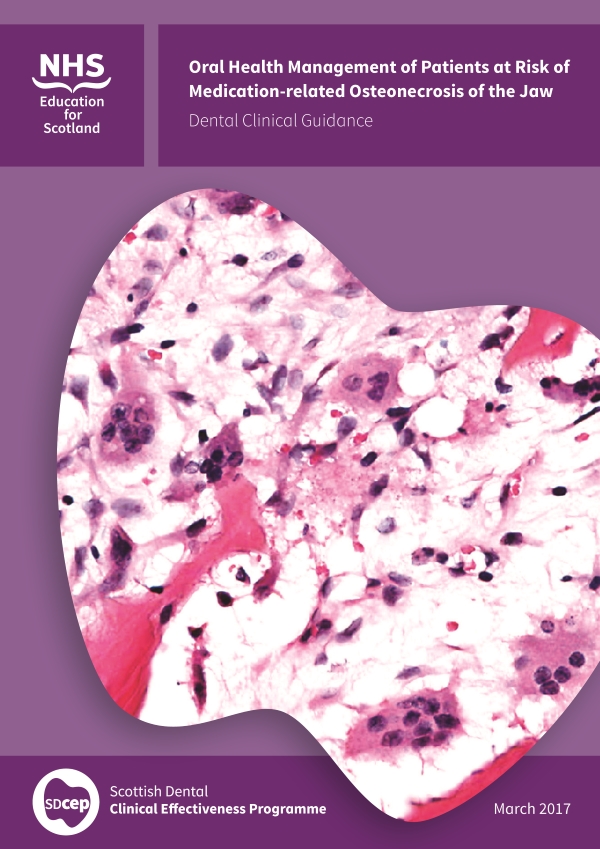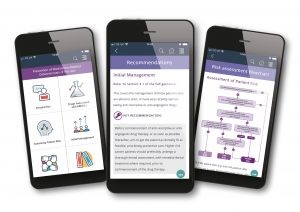
Oral Health Management of Patients at Risk of Medication-related Osteonecrosis of the Jaw
Published March 2017
Reviewed and extant March 2024 (see Review and updating for details)
Downloads
- Full Guidance (PDF) – provides comprehensive background information, recommendations and practical advice (reviewed and extant March 2024). An accessible version (Word) is also available.
- Guidance Supplement March 2024 (PDF) – provides updated information on MRONJ incidence and other drugs possibly associated with MRONJ.
- Guidance in Brief (PDF) – summarises the main recommendations from the full guidance (reviewed and extant March 2024). An accessible version (Word) is also available.
- Guidance for Prescribers and Dispensers (PDF) – highlights the recommendations relevant to those who prescribe and dispense anti-resorptive and anti-angiogenic drugs. An accessible version (Word) is also available.
These publications are only available as downloadable online resources. They are not available in print.
 Also available via the SDCEP Dental Companion website.
Also available via the SDCEP Dental Companion website.
NICE accredited the guidance development process used by SDCEP to produce its Oral Health Management of Patients at Risk of Medication-related Osteonecrosis of the Jaw guidance.
Supporting tools
A number of supporting tools are included with the full guidance to assist the dental team to implement the guidance recommendations. These are available for download and printing.
- Information Leaflets for Patients – these may be used to provide information to patients prescribed anti-resorptive or anti-angiogenic drugs and as the basis for further discussion:
Dental advice for patients prescribed anti-resorptive drugs for the treatment of osteoporosis or other non-malignant diseases of bone (PDF) - updated March 2024
Dental advice for patients prescribed anti-resorptive or anti-angiogenic drugs for the treatment of cancer (PDF) - updated March 2024
- Risk Assessment Flowchart (PDF) – a stand-alone, printable version of the flowchart from Section 3 of the guidance;
- Managing the Health of Patients at Risk of MRONJ (PDF)– a stand-alone, printable version of the flowchart from Appendix 3 of the guidance;
- Powerpoint Slide Set (PowerPoint) – a summary of the key messages from the guidance.
- List of Drugs Associated with MRONJ - March 2024 (PDF)– a list of the drugs with an MHRA Drug Safety Update for MRONJ.
About this guidance
There is an increased risk of oral health complications for patients prescribed anti-resorptive or anti-angiogenic drugs (medication-related osteonecrosis of the jaw, MRONJ). This guidance provides recommendations, advice and information to help dental practitioners manage the routine dental care of patients prescribed these drugs and is an update to the previous SDCEP Oral Health Management of Patients Prescribed Bisphosphonates guidance.
The guidance is aimed primarily at dentists in primary care dental practice and will also be of relevance to the secondary care dental service, those involved in dental education and undergraduate trainees. The guidance is also of relevance to prescribers and dispensers of bisphosphonates and to patients.
Guidance development
The guidance is based on a review of available evidence and the opinion of dental and medical experts and experienced practitioners and has been subject to open consultation prior to finalising for publication. The methodology used for the development of this guidance, including details of the evidence search strategy, evidence appraisals and information about conflict of interests can be found in the Oral Health Management of Patients at Risk of Medication-related Osteonecrosis of the Jaw Guidance Development Methodology (PDF). Further information on the SDCEP guidance development process is available or contact the SDCEP office (scottishdental.cep@nes.scot.nhs.uk).
During the development process, potential barriers to the implementation of this guidance were identified. A Guidance Implementation Summary (PDF) of information about these is provided. For further details visit the TRiaDS website.
A multidisciplinary Guidance Development Group, consisting of individuals from a range of branches of the dental and medical professions together with two patient representatives, was convened to develop and write this guidance, assisted by our Programme Development Team.
Review and updating
In line with SDCEP’s standard five-year guidance review period, a scheduled review of the guidance topic commenced in 2022. The review did not identify any evidence or other information to warrant changing the key recommendations or clinical advice in the guidance. Therefore, the 2017 edition of the guidance remains essentially unchanged and extant. Details of the review process and findings can be found in the MRONJ Surveillance Review Report 2024 (PDF).
The review did identify newer studies reporting on MRONJ incidence and on drugs associated with MRONJ. Stakeholder feedback indicated that up-to-date information about these would be helpful to inform risk assessment and discussion with patients. Consequently, a supplement to the guidance has been developed providing recent estimates of MRONJ incidence in patients treated for cancer, osteoporosis or other conditions, and updated information on drugs that might be associated with MRONJ.
Further review of this guidance may be triggered if any significant developments are identified prior to the next scheduled review in 2029.
